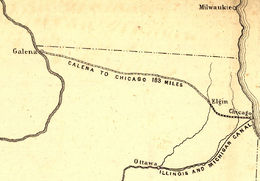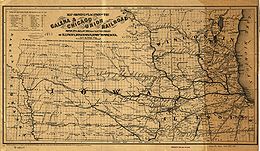
Pecatonica is a village in Winnebago County, Illinois, United States. It is part of the Rockford, Illinois Metropolitan Statistical Area. The population was 2,195 at the 2010 census, up from 1,997 in 2000.

The Chicago and North Western was a Class I railroad in the Midwestern United States. It was also known as the "North Western". The railroad operated more than 5,000 miles (8,000 km) of track at the turn of the 20th century, and over 12,000 miles (19,000 km) of track in seven states before retrenchment in the late 1970s. Until 1972, when the employees purchased the company, it was named the Chicago and North Western Railway.
The Lake Shore and Michigan Southern Railway, established in 1833, and sometimes referred to as the Lake Shore, was a major part of the New York Central Railroad's Water Level Route from Buffalo, New York, to Chicago, Illinois, primarily along the south shore of Lake Erie and across northern Indiana. The line's trackage remains a major rail transportation corridor used by Amtrak passenger trains and several freight lines; in 1998, its ownership was split at Cleveland, Ohio, between CSX Transportation to the east and Norfolk Southern Railway in the west.

The Illinois Central Railroad, sometimes called the Main Line of Mid-America, was a railroad in the Central United States. Its primary routes connected Chicago, Illinois, with New Orleans, Louisiana, and Mobile, Alabama, and thus, the Great Lakes to the Gulf of Mexico. Another line connected Chicago west to Sioux City, Iowa (1870), while smaller branches reached Omaha, Nebraska (1899) from Fort Dodge, Iowa, and Sioux Falls, South Dakota (1877), from Cherokee, Iowa. The IC also ran service to Miami, Florida, on trackage owned by other railroads.
The following railroads have been named Union Railroad or Union Railway, usually because they connected or merged several other railroads.

The Union Pacific West Line (UP-W) is a Metra commuter rail line operated by Union Pacific Railroad in Chicago, Illinois and its western suburbs. Metra does not refer to its lines by particular colors, but the timetable accents for the Union Pacific West line are "Kate Shelley Rose" pink, honoring an Iowa woman who saved a Chicago & North Western Railway train from disaster in 1881. Green and yellow were already selected for the Union Pacific North Line and Union Pacific Northwest Line, respectively, so pink was chosen for this line. Therefore, the UP-W is the only Metra line that uses a color to honor a person instead of a fallen flag railroad. Until the late 1940s the line had a branch to Freeport, Illinois. It diverged from the main line at West Chicago and had stations at Elgin, Marengo, Belvidere, Rockford, Freeport, and other communities. The line was once known as the Chicago & Northwestern/West Line until UP took over the C&NW in 1995. All Metra trains on this line terminated at Geneva until 2006, when the line was extended to its present terminus in Elburn. The line runs as part of the Union Pacific Railroad's Geneva Subdivision.
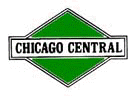
The Chicago Central and Pacific Railroad is part of the Illinois Central Railroad (IC), which is owned by the Canadian National Railway (CN) through the Grand Trunk Corporation. Operationally, the Chicago Central & Pacific is designated as the Iowa Zone of CN's Southern Region.
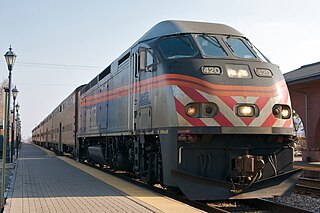
The Milwaukee District West Line (MD-W) is a Metra commuter rail line in Chicago, Illinois, and its western suburbs. Metra does not refer to any of its lines by a particular color, but the timetable accents for the Milwaukee District West line are dark "Arrow Yellow," honoring the Milwaukee Road's Arrow passenger train. Trains are dispatched from the Canadian Pacific Kansas City Railway's American headquarters in Minneapolis.

The Black Hawk was an Amtrak passenger train service that operated from 1974 to 1981 between Chicago, Illinois, and Dubuque, Iowa, via Rockford, Illinois. The original Black Hawk operated over the Illinois Central route, now the Canadian National's Chicago Central/Iowa Zone.

The Pittsburgh, Cincinnati, Chicago and St. Louis Railroad, commonly called the Pan Handle Route, was a railroad that was part of the Pennsylvania Railroad system. Its common name came from its main line, which began at Pittsburgh, Pennsylvania, crossed the Northern Panhandle of West Virginia, and continued west to Bradford, Ohio, where it split into a northern line to Chicago and a southern one through Indianapolis, Indiana, to East St. Louis, Illinois.

Wells Street Station was a passenger terminal of the Chicago and North Western Railway, located at the southwest corner of Wells Street and Kinzie Street in Chicago, Illinois. It was replaced in 1911 by the Chicago and North Western Terminal on the other (west) side of the North Branch of the Chicago River, removing passenger trains from the Kinzie Street railroad bridge over the river. The Merchandise Mart opened in 1930 on the land formerly occupied by the station.

U.S. Route 20 (US 20) in the U.S. state of Illinois is a major arterial highway that runs from the Iowa state line at East Dubuque at the northwestern tip of Illinois to the Indiana state line at Chicago south of the Chicago Skyway, a distance of 233.93 miles (376.47 km). For its entire length, US 20 is designated as the General Ulysses S. Grant Highway, often abbreviated the U.S. Grant Memorial Highway. However, this name is only commonly used west of Elgin. US 20 bypasses the city of Elgin on a freeway known as the Elgin Bypass or Dr. Martin Luther King Jr. Memorial Highway. From Elgin to Melrose Park, US 20 follows Lake Street. It then follows Mannheim Road and, further south, La Grange Road. US 20 also follows 95th Street as it turns east through Chicago's southwestern suburbs. It ultimately leaves Illinois on Indianapolis Boulevard.
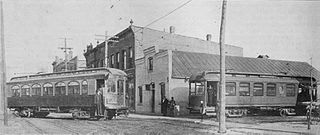
The Elgin and Belvidere Electric Company was a 36-mile (58 km) interurban line that connected Belvidere, Illinois and Elgin, Illinois. It was the central link in the interurban network connecting Freeport, Rockford, Elgin, and Chicago which included the Rockford and Interurban Railway to the west and the Chicago, Aurora and Elgin Railroad to the east. The line was operational from 1907 until 1930. In 1927, the line was extended to Rockford over a line of the Rockford and Interurban.
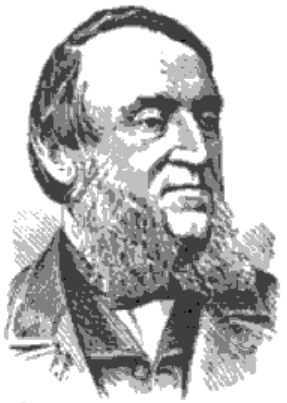
William Jarvis McAlpine was an American civil engineer and politician from New York. He was New York State Engineer and Surveyor from 1852 to 1853.

The Chicago and Aurora Railroad was a direct predecessor of the Chicago, Burlington and Quincy Railroad. Its original incorporation as the Aurora Branch Railroad, chartered in February 1849, started as a twelve-mile branch line which Class I giant BNSF cites as the beginning of their empire: this “short stretch of track set BNSF’s destiny into ‘loco-motion’ and grew over many decades into a network spanning 32,500 miles.” Beginning in 1853, as the Chicago and Aurora Railroad, the company's tracks eventually extended from Chicago to Mendota via Aurora, Illinois, also creating what would become the oldest commuter line in the Chicago area.
The Galena–Chicago trail was a stagecoach route located in northern Illinois that ran from the mid-to-late 1830s until 1854. As indicated by its name, the route linked Chicago, located in the northeast of the state, with Galena which was located in the lead mining district of the northwest. The Chicago-Galena trail includes the "Stagecoach Trail" that runs between Galena and Lena, Illinois. East of Lena the stage route follows U.S. Route 20 and Business U.S. Route 20 through Eleroy, Freeport and Rockford to Belvidere. This road began as the old State Road number 2 established on 15 January 1836 and laid out by June 1837.

Several special routes of U.S. Route 20 (US 20) exist. In order from west to east, they are as follows.

The Cleveland, Painesville and Ashtabula Railroad (CP&A), also known informally as the Cleveland and Erie Railroad, the Cleveland and Buffalo Railroad, and the Lake Shore Railroad, was a railway which ran from Cleveland, Ohio, to the Ohio-Pennsylvania border. Founded in 1848, the line opened in 1852. The railroad completed the rail link between Buffalo, New York, and Chicago, Illinois.
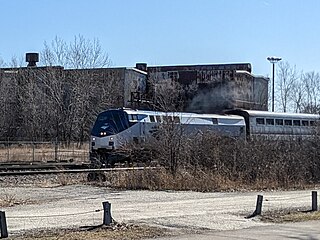
The Joliet Subdivision is a railroad subdivision of the Canadian National Railway in the Chicago metropolitan area. The 33-mile route runs from Joliet, Illinois to Chicago's Bridgeport neighborhood, largely paralleling the route of the Illinois and Michigan Canal. Union Pacific has trackage rights over the route, which meets the Union Pacific Joliet Subdivision at Joliet to reach Bloomington and St. Louis. The line also hosts Metra's Heritage Corridor commuter service, and Amtrak's Lincoln and Texas Eagle service. From Bridgeport, services reach Chicago Union Station via Canadian National's Freeport Subdivision.
